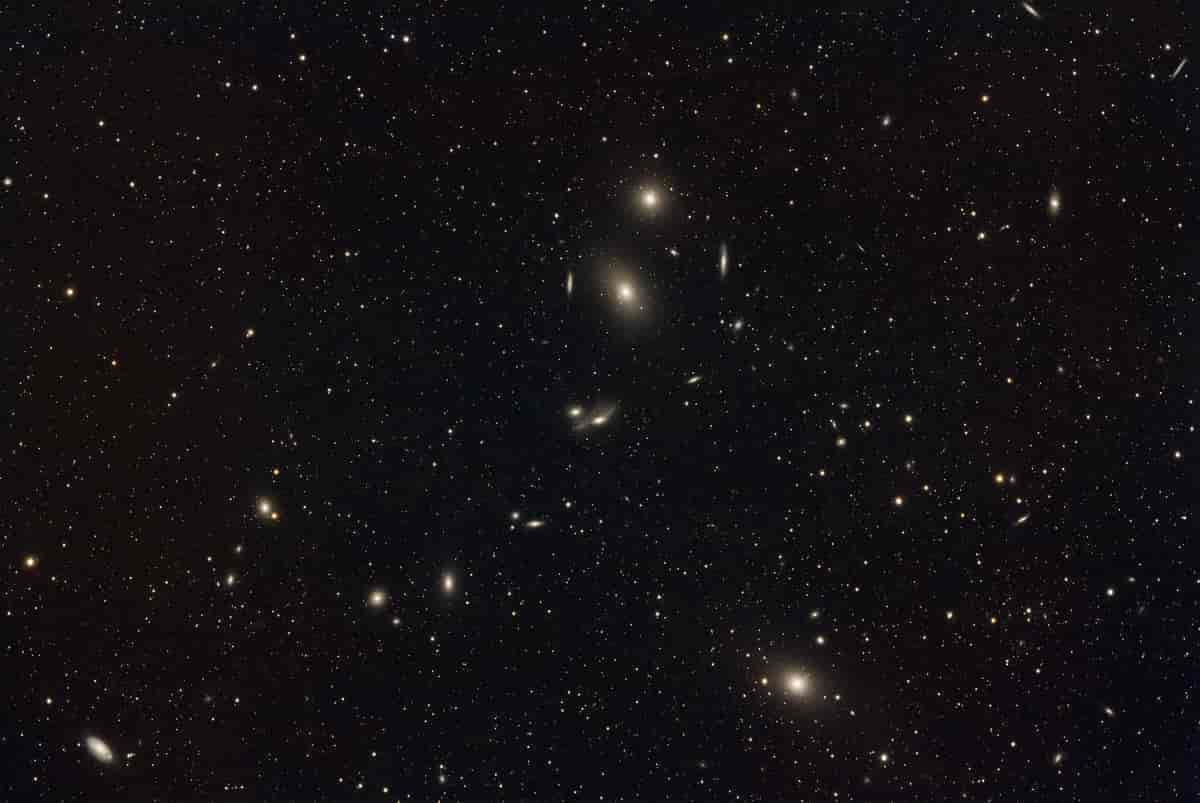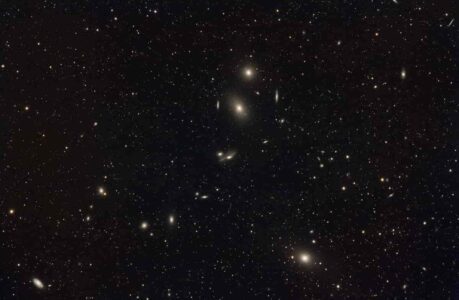The constellation Virgo, also known as the Virgin, is one of the largest and brightest constellations in the sky. It is located in the zodiacal band and is one of the twelve zodiacal constellations. Virgo is visible in the northern hemisphere from March to July, and in the southern hemisphere from September to February.
History and Mythology
The history and mythology of Virgo can be traced back to ancient times. In Greek mythology, Virgo represents the goddess of harvest and fertility, Demeter. According to the myth, Demeter was the daughter of Cronus and Rhea and the sister of Zeus. She was responsible for the growth of crops and the abundance of harvests.
In another version of the myth, Demeter’s daughter, Persephone, was abducted by Hades, the god of the underworld. Demeter went in search of her daughter and during her search, she neglected her duties as the goddess of harvest. This resulted in a drought and famine, and Zeus had to intervene to bring Persephone back to her mother.
The Babylonians also associated Virgo with a goddess, known as Shala, who was the patron of agriculture and fertility. The Egyptians, on the other hand, associated Virgo with the goddess Isis, who was the goddess of nature, magic, and fertility.
Astronomical Significance
Virgo is the second-largest constellation in the sky, after Hydra, and is located between the constellations Leo and Libra. It contains numerous bright stars, including Spica, which is one of the brightest stars in the sky.
Spica is a binary star system, which means it is composed of two stars that orbit around a common centre of mass. The two stars are very close to each other, and their combined brightness makes Spica one of the brightest stars in the sky.
Virgo is also home to numerous galaxies, including the Virgo Cluster, which is a group of galaxies that are located approximately 54 million light-years away from Earth. The Virgo Cluster contains over 1,300 galaxies and is the closest galaxy cluster to our Milky Way.
How can I find Virgo
To find the constellation Virgo in the night sky, you can start by looking for its brightest star, Spica. Spica is a blue-white star and is one of the brightest stars in the sky. It is located in the southern part of the constellation and can be seen in the eastern sky in the late evening during the spring and summer months in the northern hemisphere.
Once you have located Spica, you can trace the constellation Virgo from there. Virgo is located between the constellations Leo and Libra and is easy to spot due to its large size and distinctive shape. The constellation resembles a young woman holding a bundle of wheat in her left hand.
You can also use a star chart or a stargazing app to help you locate Virgo in the night sky. These resources will show you the exact location of the constellation and help you identify its major stars and features.
When viewing the constellation Virgo, it is best to find a dark location away from city lights and allow your eyes to adjust to the darkness. This will allow you to see the fainter stars in the constellation and appreciate its beauty and significance in the night sky.
The Stars in Virgo
The constellation Virgo is home to many stars of varying brightness and size. Here are some of the most notable stars in Virgo:
- Spica – Spica is the brightest star in Virgo and is one of the brightest stars in the sky. It is a binary star system, composed of two stars that orbit around a common centre of mass. Spica is approximately 250 light-years away from Earth and is one of the most massive and luminous stars in our galaxy.
- Porrima – Porrima is a binary star system that is located in the western part of the constellation. It is composed of two stars that orbit each other every 169 years. Porrima is also known as Gamma Virginis and is approximately 38 light-years away from Earth.
- Vindemiatrix – Vindemiatrix is a yellow giant star that is located in the eastern part of the constellation. It is also known as Epsilon Virginis and is approximately 109 light-years away from Earth.
- Zavijava – Zavijava is a blue-white star that is located in the southern part of the constellation. It is also known as Beta Virginis and is approximately 36 light-years away from Earth.
- Auva – Auva is a red giant star that is located in the northeastern part of the constellation. It is also known as Delta Virginis and is approximately 102 light-years away from Earth.
In addition to these stars, Virgo is also home to numerous fainter stars that can be difficult to see with the naked eye. It is also home to many galaxies, including the Virgo Cluster, which is a group of galaxies that is located approximately 54 million light-years away from Earth. The Virgo Cluster is the closest galaxy cluster to our Milky Way and contains over 1,300 galaxies.
The Virgo Cluster
The Virgo Cluster is a large group of galaxies that is located in the constellation Virgo. It is the closest galaxy cluster to our Milky Way galaxy, and it contains over 1,300 galaxies. The Virgo Cluster is a massive structure, and its gravitational pull affects the motion of galaxies and stars in the surrounding area.
The Virgo Cluster was discovered in the late 1700s by French astronomer Charles Messier, who catalogued many of the bright objects in the night sky. He initially thought that the Virgo Cluster was a single nebula, but subsequent observations revealed it to be a group of galaxies.
The galaxies in the Virgo Cluster range in size and shape, from large spiral galaxies like the Milky Way to small, irregular galaxies. The brightest galaxy in the cluster is Messier 87 (M87), which is a giant elliptical galaxy that contains a supermassive black hole at its centre.
The Virgo Cluster is an important object of study for astronomers, as it provides insights into the formation and evolution of galaxies. Observations of the cluster have revealed that galaxies within it are moving at high speeds, indicating that they are being affected by the cluster’s gravitational pull. The cluster also contains many examples of galaxy interactions, where galaxies are interacting with each other through gravitational forces. These interactions can lead to the formation of new stars and can also cause the galaxies to change shape.
The Virgo Cluster is a popular target for amateur astronomers, as it can be seen through small telescopes. However, to fully appreciate the cluster’s size and structure, larger telescopes are needed. In addition to optical telescopes, observations of the Virgo Cluster are also made using radio, X-ray, and infrared telescopes, which can provide insights into the cluster’s properties and composition.
In conclusion, the Virgo Cluster is a fascinating object of study for astronomers, as it provides insights into the formation and evolution of galaxies. Its proximity to our Milky Way galaxy and its large size make it a popular target for observational studies, and it remains one of the most important objects in the study of astronomy.
Other notable Deep Sky objects in Virgo
In addition to the Virgo Cluster, the constellation Virgo is home to many other notable deep sky objects. Here are some of the most interesting ones:
- Sombrero Galaxy – The Sombrero Galaxy is a stunning spiral galaxy that is located in the southern part of the constellation. It is also known as Messier 104 and is easily recognizable due to its distinct shape, which resembles a sombrero hat. The galaxy is approximately 28 million light-years away from Earth.
- Markarian’s Chain – Markarian’s Chain is a group of galaxies that is located in the eastern part of the constellation. It is a series of about a dozen galaxies that are arranged in a long chain. Markarian’s Chain is part of the Virgo Cluster and is located approximately 50 million light-years away from Earth.
- NGC 4388 – NGC 4388 is a barred spiral galaxy that is located in the northern part of the constellation. It is approximately 60 million light-years away from Earth and is notable for its distorted shape, which is thought to have been caused by interactions with other galaxies.
- NGC 4526 – NGC 4526 is an elliptical galaxy that is located in the southern part of the constellation. It is approximately 55 million light-years away from Earth and is notable for its dark dust lane, which is thought to be the result of an ancient collision with another galaxy.
- NGC 4697 – NGC 4697 is an elliptical galaxy that is located in the western part of the constellation. It is approximately 50 million light-years away from Earth and is notable for its large globular cluster system, which contains over 400 globular clusters.
These deep sky objects can be viewed through small telescopes, but to fully appreciate their size and structure, larger telescopes are needed. Many amateur astronomers visit dark sky sites to observe these deep sky objects, and they remain a popular target for observational studies.
Where does the Name Virgo come from
The name “Virgo” comes from the Latin word for “virgin.” In Greek mythology, the constellation Virgo represents the goddess of harvest and fertility, Demeter, who was also associated with the virgin goddess Hestia. However, the name “Virgo” was not used in Greek mythology, but instead, it was used by the Romans who adopted the constellation from the Greeks.
The constellation Virgo has been known and recognized by various cultures throughout history. In ancient Egypt, the constellation was associated with the goddess Isis, who was the goddess of nature, magic, and fertility. In Babylonian astronomy, the constellation was known as “The Furrow,” and it was associated with the goddess Shala, who was the patron of agriculture and fertility.
The origin of the name “Virgo” is not entirely clear, but it is believed to have been first used by the Romans in the 1st century BC. The constellation’s name was likely influenced by its association with the goddess of fertility and agriculture, as well as its location in the zodiacal band, which was associated with the changing of the seasons and the cycle of life.
In conclusion, the name “Virgo” comes from the Latin word for “virgin” and was likely adopted by the Romans due to the constellation’s association with the goddess of fertility and agriculture. The constellation has been known and recognized by various cultures throughout history, and its mythology and symbolism continue to fascinate astronomers and stargazers alike.
Conclusion
The constellation Virgo has a rich history and mythology, dating back to ancient times. It represents the goddess of harvest and fertility in Greek mythology and is associated with various other goddesses in different cultures. From an astronomical perspective, Virgo is one of the largest and brightest constellations in the sky and contains numerous bright stars and galaxies. Its proximity to our Milky Way and the presence of the Virgo Cluster make it a fascinating object of study for astronomers and stargazers alike.

